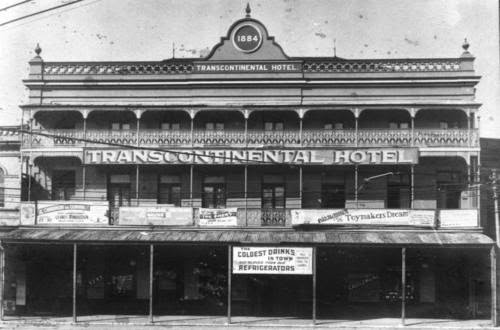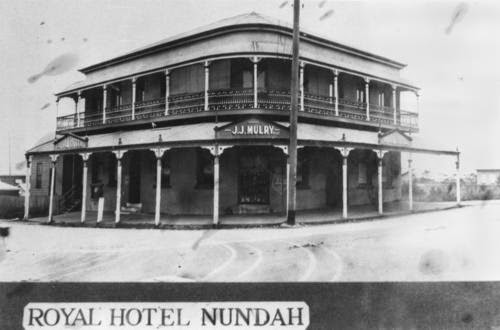The previous Queensland Government wanted to extend the current public transport networks by laying a tunnel under the river that would take both buses and trains, the unusually-christened BaT Tunnel. One of the later announcements concerned the Roma St Transit Centre. The last government thought it should be demolished to allow the tunnel to hook up with Roma St Station - the Roma St Transit Centre has a reputation as being Brisbane's ugliest building. The change in government has suspended the BaT Tunnel, so I suppose that the redevelopment of the Transit Centre is also unlikely to proceed.
Right across the road from the Transit Centre is one of Brisbane's oldest hotels, dating from 1884. It is the heritage listed Transcontinental Hotel on the corner of Roma St and George St. Here is what it looked like in its early days.
(Photo: BCC-B120-24593)
Obviously the hotel was in a prime position for travellers to Brisbane by rail as it is situated directly opposite Roma St station. It was the brainchild of prominent Brisbane identity Peter Murphy. He arrived in Brisbane from Ireland in 1871 and progressed through occupations as diverse as labourer, bullock driver, police constable and grocer before obtaining a spirit dealers' licence in 1879.
In 1883 he became the licensee of the Burgundy Hotel in George St. He had the highly regarded architect FDG Stanley design the Transcontinental Hotel and opened it in 1884. The Brisbane Courier reported that the Transcontinental Hotel contained 27 bedrooms, seven public rooms, a billiard room and a private bar. It became very popular immediately, having the largest bar trade in the city within a short time. Peter Murphy became a director and then chairman of brewer Perkins Pty Ltd, and he was president of the Queensland United Licenced Victuallers' Association for several terms. He really contributed greatly to the northern end of George St as he also was the financial backer of the McDonnell & East department store that was prominent in Brisbane for many years. Peter Murphy was a member of Queensland's upper house, the Legislative Council, from 1904 through to its abolition in 1922.
Another well-known Brisbane publican, Denis O'Connor (pictured below) took over the lease of the Transcontinental in 1906, and he immediately arranged for GHM Addison to give the interior of the hotel a makeover. When the new bar was opened in October of that year it was described as the most ornate and best equipped hotel in Australia.
(Photo: SLQ 23827)
The Murphy family owned the Transcontinental Hotel through to 1935 when it was sold to the large Queensland brewery group Castlemaine Perkins Pty Ltd. It is now owned by modern hoteliers the Austotel company who refurbished the hotel at the beginning of 2014. This is the way it looks now.
(Photo: transhotel.net.au)
Click here for a Google Map.
tff
Right across the road from the Transit Centre is one of Brisbane's oldest hotels, dating from 1884. It is the heritage listed Transcontinental Hotel on the corner of Roma St and George St. Here is what it looked like in its early days.
(Photo: BCC-B120-24593)
Obviously the hotel was in a prime position for travellers to Brisbane by rail as it is situated directly opposite Roma St station. It was the brainchild of prominent Brisbane identity Peter Murphy. He arrived in Brisbane from Ireland in 1871 and progressed through occupations as diverse as labourer, bullock driver, police constable and grocer before obtaining a spirit dealers' licence in 1879.
In 1883 he became the licensee of the Burgundy Hotel in George St. He had the highly regarded architect FDG Stanley design the Transcontinental Hotel and opened it in 1884. The Brisbane Courier reported that the Transcontinental Hotel contained 27 bedrooms, seven public rooms, a billiard room and a private bar. It became very popular immediately, having the largest bar trade in the city within a short time. Peter Murphy became a director and then chairman of brewer Perkins Pty Ltd, and he was president of the Queensland United Licenced Victuallers' Association for several terms. He really contributed greatly to the northern end of George St as he also was the financial backer of the McDonnell & East department store that was prominent in Brisbane for many years. Peter Murphy was a member of Queensland's upper house, the Legislative Council, from 1904 through to its abolition in 1922.
Another well-known Brisbane publican, Denis O'Connor (pictured below) took over the lease of the Transcontinental in 1906, and he immediately arranged for GHM Addison to give the interior of the hotel a makeover. When the new bar was opened in October of that year it was described as the most ornate and best equipped hotel in Australia.
(Photo: SLQ 23827)
The Murphy family owned the Transcontinental Hotel through to 1935 when it was sold to the large Queensland brewery group Castlemaine Perkins Pty Ltd. It is now owned by modern hoteliers the Austotel company who refurbished the hotel at the beginning of 2014. This is the way it looks now.
(Photo: transhotel.net.au)
Click here for a Google Map.
tff














































 a
a








